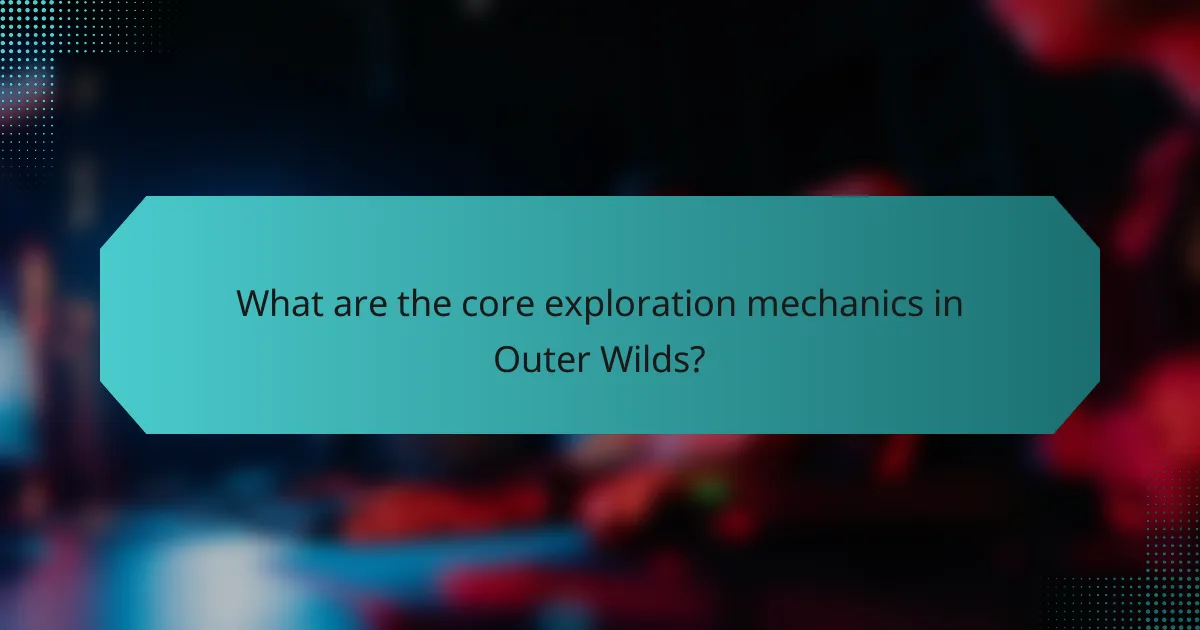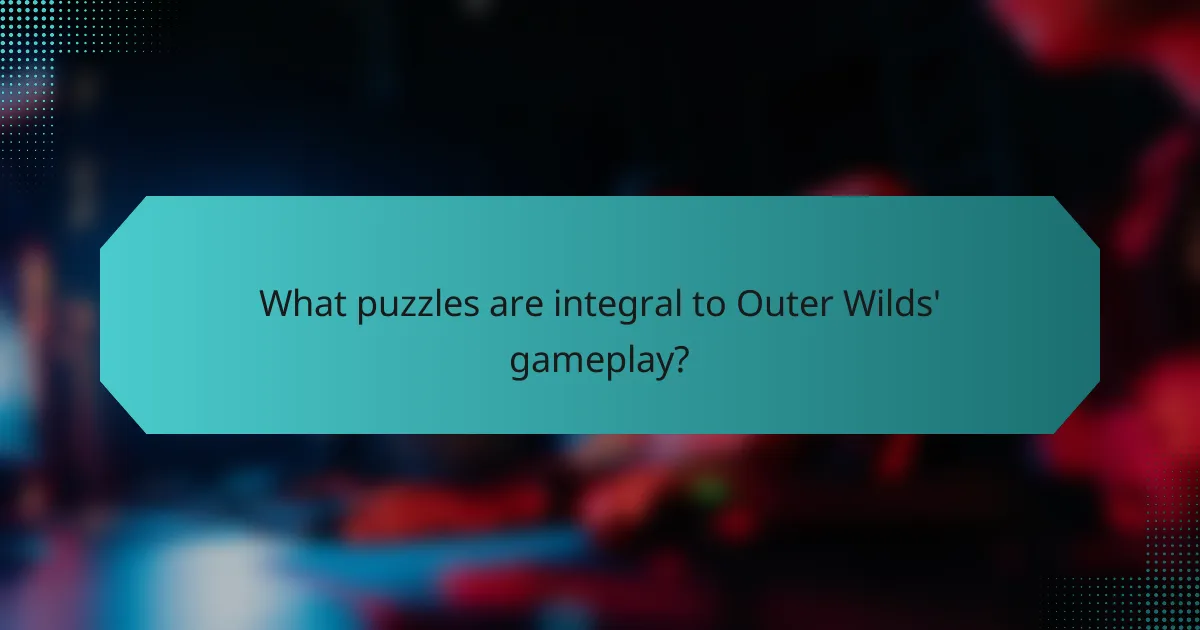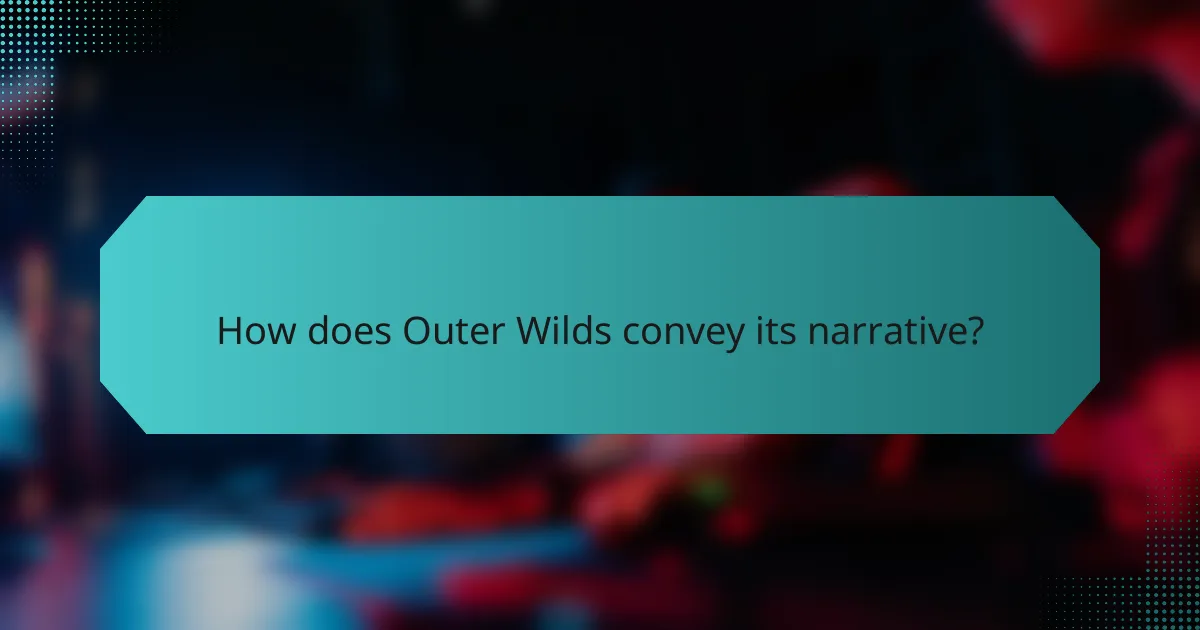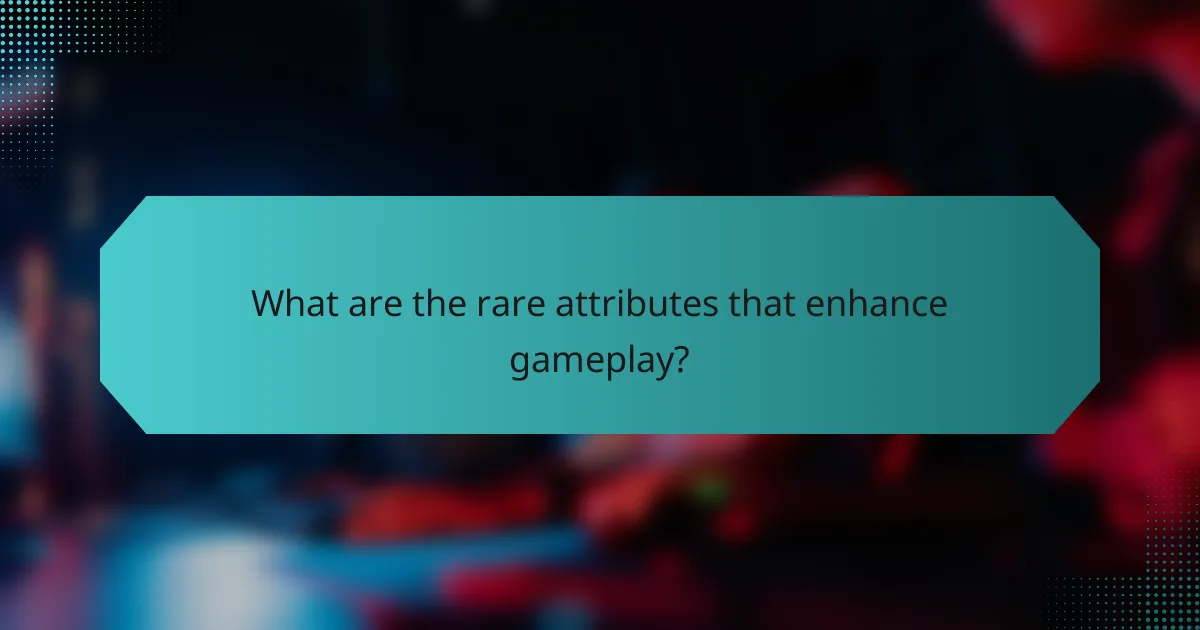Outer Wilds captivates players with its unique exploration mechanics and engaging narrative. The game emphasises curiosity and discovery through environmental storytelling and innovative puzzle design. Players navigate a dynamic solar system, experiencing a non-linear narrative that adapts to their choices. Time manipulation mechanics and strategic challenges further enhance the depth of exploration and storytelling.

What are the core exploration mechanics in Outer Wilds?
Outer Wilds features core exploration mechanics that emphasise curiosity and discovery. Players navigate a dynamic solar system, uncovering secrets through environmental storytelling and puzzle-solving. The game encourages experimentation, with time manipulation mechanics enhancing exploration depth. Unique attributes include the use of a non-linear narrative that adapts to player choices, creating a personalised experience. Rarely, players encounter environmental hazards that require strategic thinking to overcome.
How do players navigate the universe?
Players navigate the universe in Outer Wilds through exploration, utilising a spacecraft and various tools. The game emphasises curiosity and discovery, encouraging players to uncover secrets across diverse celestial bodies. Players must solve environmental puzzles that integrate seamlessly with the narrative, leading to a deeper understanding of the game’s lore. Unique mechanics, such as time loops and gravity manipulation, enhance the exploration experience, making navigation both challenging and rewarding.
What role does time play in exploration?
Time plays a critical role in exploration by creating a sense of urgency and discovery. In “Outer Wilds,” the 22-minute time loop challenges players to uncover secrets and solve puzzles before the universe resets. This mechanic enhances storytelling by intertwining exploration with the consequences of time, making each discovery feel impactful. Players must strategise their actions, balancing exploration with the limited time available. The unique attribute of this time constraint fosters a deeper emotional connection to the game’s narrative, as players experience the inevitability of cosmic events.
Which tools enhance exploration?
Outer Wilds enhances exploration through tools like the spaceship, the signal scope, and the quantum locator. These tools facilitate navigation, puzzle-solving, and uncovering the story. The spaceship allows players to traverse various celestial bodies, while the signal scope helps locate points of interest. The quantum locator provides insights into the unique quantum mechanics of specific objects, enriching the exploration experience.
How does environmental design influence player movement?
Environmental design significantly shapes player movement in Outer Wilds by creating immersive exploration experiences. The game’s unique attributes, such as gravity shifts and diverse planetary environments, encourage players to navigate in innovative ways. For example, the design of the Hourglass Twins features sand that alters pathways, prompting players to adapt their movement strategies. This interactivity enhances puzzle-solving, as players must understand how the environment influences their actions. As a result, environmental design not only guides player movement but also intertwines with storytelling, enriching the overall gameplay experience.

What puzzles are integral to Outer Wilds’ gameplay?
Outer Wilds integrates various puzzles that enhance exploration and storytelling. Key puzzles include environmental challenges, time-based mechanics, and lore-based riddles. Players manipulate gravity, navigate complex structures, and decode ancient messages to progress. Each puzzle is designed to deepen the narrative and enrich the player’s experience, making them essential to gameplay.
How are puzzles structured around exploration?
Outer Wilds structures puzzles around exploration by integrating discovery with narrative elements. Players encounter environmental clues that lead to deeper understanding of the game’s lore. The mechanics encourage curiosity and experimentation, allowing players to piece together the story through exploration. Unique attributes include the time loop mechanic, which creates urgency and influences puzzle-solving strategies. Rare attributes, such as the interconnectedness of celestial bodies, enhance the sense of wonder and exploration.
What types of puzzles challenge players’ logic?
Outer Wilds features logic puzzles that engage players through exploration and environmental storytelling. These puzzles often rely on clues found in the game world, requiring players to connect disparate pieces of information. Examples include deciphering ancient texts, navigating celestial mechanics, and solving intricate puzzles tied to the game’s lore. Each puzzle encourages critical thinking and promotes a sense of discovery, making them integral to the overall experience.
How does the game use environmental storytelling in puzzles?
Outer Wilds effectively uses environmental storytelling in puzzles by integrating narrative elements into the game world. Players uncover the history and lore through exploration, observing remnants of past civilisations and their interactions with the environment. This design encourages players to piece together stories from visual clues, such as ancient structures and artefacts, enhancing immersion. The puzzles often require players to interpret these environmental cues, making the act of solving them a narrative-driven experience. This approach not only enriches gameplay but also deepens emotional engagement with the story.

How does Outer Wilds convey its narrative?
Outer Wilds conveys its narrative through immersive exploration mechanics, intricate puzzle design, and innovative storytelling techniques. Players uncover the story organically by exploring diverse planets and piecing together lore through environmental storytelling. The game’s time loop mechanic enhances the narrative, creating urgency and emotional depth as players witness the consequences of their actions. Unique attributes include the non-linear storytelling approach, allowing players to discover events in their own order, fostering a personal connection to the narrative. The combination of these elements results in a rich, engaging experience that invites players to reflect on themes of curiosity, discovery, and the passage of time.
What techniques are used to immerse players in the story?
Outer Wilds employs various techniques to immerse players in its story, including environmental storytelling, non-linear exploration, and dynamic interactions. Players uncover lore through exploration, discovering artefacts and remnants of ancient civilisations. The game encourages curiosity, allowing players to piece together narratives organically. Time loops enhance immersion, as players experience the consequences of their actions, deepening emotional engagement. Unique attributes like the game’s atmospheric soundtrack further enrich the storytelling experience, creating a profound connection to the narrative.
How does non-linear storytelling affect player experience?
Non-linear storytelling enhances player experience by creating a sense of discovery and engagement. In “Outer Wilds,” players explore a vast universe where time loops and fragmented narratives encourage exploration and critical thinking. This structure allows players to piece together the story at their own pace, fostering a deeper emotional connection to the game. The unique attribute of time manipulation in its storytelling design amplifies the impact of player choices, making each discovery feel significant. As a result, players experience a more personalised journey, leading to varied interpretations and memorable gameplay moments.
Which character interactions are pivotal to the narrative?
Character interactions in Outer Wilds are crucial for narrative depth and player engagement. The relationships between characters, such as the Nomai and the Hearthians, reveal backstory and motivations. For example, the Nomai’s exploration of the universe and their fate is intertwined with the player’s journey. The interactions often provide clues for solving puzzles and understanding the game’s lore. Additionally, emotional connections formed through dialogue enhance the storytelling experience, making the world feel alive and interconnected.

What unique attributes set Outer Wilds apart from other games?
Outer Wilds stands out due to its unique blend of exploration mechanics, puzzle design, and narrative depth. The game emphasises a non-linear exploration approach, allowing players to uncover secrets at their own pace. Its puzzles are intricately tied to the environment, requiring observation and experimentation rather than traditional mechanics. The storytelling is woven into the gameplay, with lore revealed through exploration, creating an immersive experience. This combination fosters a sense of wonder and discovery, making Outer Wilds a distinctive entry in the gaming landscape.
How does the art style contribute to the overall experience?
The art style of Outer Wilds enhances the overall experience by creating an immersive and atmospheric environment. Its unique visual design evokes a sense of wonder and curiosity, encouraging exploration. The use of vibrant colours and distinct planetary features contributes to the game’s storytelling, making each location feel alive and significant. The art style also supports puzzle design by visually guiding players and hinting at potential solutions through environmental cues. Overall, the combination of these elements deepens player engagement and enriches the narrative journey.
What innovative gameplay mechanics are exclusive to Outer Wilds?
Outer Wilds features innovative gameplay mechanics that emphasise exploration, time manipulation, and environmental storytelling. The game uniquely employs a non-linear narrative structure where players uncover mysteries through exploration rather than conventional quests. Its time loop mechanic allows players to experience the consequences of their actions within a 22-minute cycle, fostering a sense of urgency and discovery. Additionally, the game’s unique physics-based puzzles encourage creative problem-solving and interaction with the environment, enhancing immersion and player agency.

What are the rare attributes that enhance gameplay?
Rare attributes that enhance gameplay in Outer Wilds include dynamic environmental interactions, non-linear storytelling, and the integration of time loops. These elements create a unique exploration experience. The game’s mechanics allow players to uncover secrets organically, fostering curiosity. Additionally, the absence of traditional fail states encourages experimentation, making each playthrough distinct.
How do player choices impact the story’s outcome?
Player choices significantly influence the narrative and outcomes in Outer Wilds. Decisions shape exploration paths, puzzle-solving strategies, and character interactions. This dynamic system encourages players to engage deeply with the story, as each choice leads to unique discoveries and consequences. For example, exploring different planets reveals varied lore and impacts the game’s conclusion. The non-linear storytelling technique allows for multiple interpretations, enhancing replayability and player agency.
What hidden secrets can players discover?
Players can discover various hidden secrets in Outer Wilds through exploration and keen observation. The game rewards curiosity, leading to uncovering ancient alien civilisations and their technologies. Unique attributes include the interstellar travel mechanics that allow players to visit diverse planets, each with distinct environments and puzzles. Rare secrets involve uncovering lore through environmental storytelling, revealing the history and fate of the Nomai. Players often find themselves piecing together clues scattered across the solar system, enhancing the overall narrative experience.

What best practices can enhance the Outer Wilds experience?
To enhance the Outer Wilds experience, players should focus on exploration, puzzle-solving, and narrative immersion. Embrace curiosity by thoroughly investigating each environment, as this reveals hidden lore and mechanics.
Utilise the game’s unique time loop to experiment with different strategies for solving puzzles. This encourages creative thinking and allows players to experience the consequences of their actions.
Engage with non-playable characters to uncover deeper story elements, as their dialogues often contain clues that enrich the overall narrative.
Lastly, consider sharing experiences with others to gain new perspectives and insights, fostering a community of exploration and discovery.
How can players effectively manage their time in-game?
Players can effectively manage their time in Outer Wilds by prioritising exploration and puzzle-solving. Focus on gathering information from different planets and using the knowledge to unlock new areas. Set specific goals for each play session, such as completing a puzzle or discovering a new location. Utilise the game’s time loop to experiment with various strategies without the pressure of permanent failure. Plan visits to planets based on the time of day, as certain events only occur during specific cycles. Embrace the non-linear narrative to explore at your own pace while ensuring you cover essential story elements.
What strategies can help solve complex puzzles?
Exploring complex puzzles in Outer Wilds requires curiosity, observation, and experimentation. Players should focus on environmental storytelling, use clues from the surroundings, and engage with the game’s physics mechanics to uncover solutions.
Understanding the interconnectedness of the game’s worlds enhances puzzle-solving. Players can also benefit from revisiting locations with new knowledge or tools, as this often reveals hidden paths or insights.
Collaborative discussions with other players can provide fresh perspectives, while taking notes can help track progress and connections between puzzles. Embracing trial and error fosters a deeper understanding of the game mechanics and narrative.
Which common mistakes should players avoid?
Players should avoid rushing through the game, overlooking environmental clues, and neglecting to explore thoroughly. These common mistakes can hinder progress and enjoyment in Outer Wilds.
1. Rushing through the game can lead to missed story elements and puzzles.
2. Ignoring environmental clues can prevent solving critical challenges.
3. Failing to explore thoroughly may result in missing vital upgrades and lore.
4. Not experimenting with mechanics can limit understanding of the game’s systems.